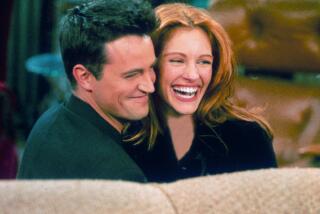Chirps, Burps and Bowwows
- Share via
When Jerry Seinfeld was forced to take care of a dog named Farfel this season on “Seinfeld,” the sitcom’s producers did not turn to an animal handler to cast the canine character. Because Farfel never appeared on camera, they called upon actor Tom Williams to provide the doggy yips and yowls.
Over on another NBC show, “Empty Nest,” the Weston family played host for one episode to a howling infant. Rest assured that no child abuse was involved in eliciting the required cries: During the taping, 77-year-old actress Norma Ransom bawled like a baby into a microphone.
Actors supply voices for cartoon characters, of course. But even on live-action shows, the squawking babies and talking parrots, the buzzing flies, honking geese and any number of other animal noises are not necessarily the real thing. Producers who want their casts to react naturally and spontaneously to such sounds regularly turn to Williams, Ransom and a handful of other performers to provide on-the-spot renditions of whatever vocal gymnastics a script requires.
“The actors have something to play off of,” explained Ransom, a stage and commercial actress who learned how to do baby cries during her Chicago radio days in the 1930s. She first cried for the cameras as Billy Crystal’s daughter in “Soap,” and has since been heard on “The Golden Girls,” “It’s a Living,” “The Jeffersons” and “Amen.” “You can react to what’s going on, and they can, too.”
Adults also cry, bark and buzz on cue more dependably than their real-life counterparts, said Williams, 63, who made his vocal acting debut saying, “Hello, turkey” for Robert Blake’s cockatoo on “Baretta” following numerous traditional acting credits and a stint as producer of the cop series “Adam-12.’
Live actors are also more versatile than recordings.
On Lucille Ball’s last series, “Life with Lucy,” for instance, Williams was hired to impersonate a fly that Ball was trying to swat, calling not only for standard buzzing but sounds indicating that the insect was circling in loops.
“You can’t find a fly who will do exactly what the script says,” Williams said. “And it’s almost impossible to come up with a recording that can do whatever crazy idea a writer might have.”
Despite the somewhat frivolous nature of the job, the voice actors take their work seriously. “Let’s say it’s a parrot,” Williams said. “I go through the script: Who is he? What does he do? You become like the parrot. If it’s a baby (he’s played Murphy Brown’s half-brother, among others), I ask the producer, ‘Is the baby hungry? Tired? Annoying? What do you want it to be?’ ”
Indeed, a voice actor should be treated as another cast member, says veteran agent Don Pitts, who represented the late Mel Blanc and handles other vocal luminaries. “In cartoons, you have to play everything very big, very broad, chewing up the scenery. In live action, though, the actor has to be able to work in a believable situation, not acting silly. He has to have much more of a dramatic flair. It’s not just crying like a baby, it’s giving an interpretation.”
Accordingly, when doing sitcoms, both Ransom and Williams prefer to be present for an episode’s entire three- or four-day rehearsal period rather than just showing up on tape day. During the taping, they usually stand behind the set, watching the action on a monitor while awaiting their cues.
How do series cast members react to such vocal antics?
“They’re fascinated by what we do,” said Ransom, who specializes in infants up to four months old. “On ‘Empty Nest,’ David Leisure, who had just had a baby, said, ‘Oh my gosh, that sounds just like my baby!’ ”
No matter how thorough the performer’s preparation though, things don’t always go as planned. “When I auditioned for ‘Seinfeld,’ I yapped, because they said it was an annoying dog, high-pitched,” Williams said. “Then the first day on the set, they said, ‘It doesn’t sound right. Go for a larger dog.’ ”
Such mishaps are rare, as Williams does his homework by listening to animal and bird tapes and visiting hospital nurseries; Ransom relies on her memories of her children, grandchildren and great-grandchildren. But a Williams assignment on “Mama’s Family” precluded any such training: after all, just how do you study to be the voice of an automated teller machine?
More to Read
The complete guide to home viewing
Get Screen Gab for everything about the TV shows and streaming movies everyone’s talking about.
You may occasionally receive promotional content from the Los Angeles Times.






